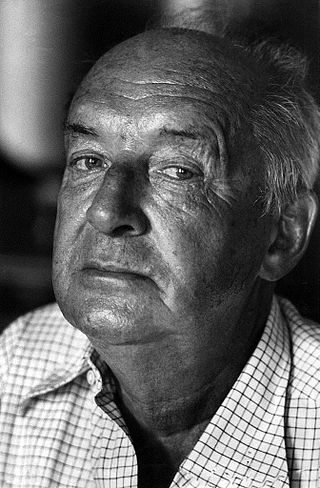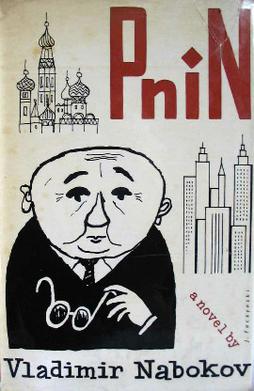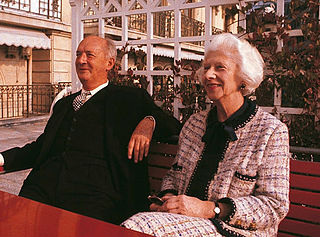
Mars, the fourth planet from the Sun, has appeared as a setting in works of fiction since at least the mid-1600s. Trends in the planet's portrayal have largely been influenced by advances in planetary science. It became the most popular celestial object in fiction in the late 1800s when it became clear that there was no life on the Moon. The predominant genre depicting Mars at the time was utopian fiction. Around the same time, the mistaken belief that there are canals on Mars emerged and made its way into fiction, popularized by Percival Lowell's speculations of an ancient civilization having constructed them. The War of the Worlds, H. G. Wells' story of an alien invasion of Earth by sinister Martians, was published in 1897 and went on to have a large influence on the science fiction genre.

Vladimir Vladimirovich Nabokov, also known by the pen name Vladimir Sirin, was an expatriate Russian and Russian-American novelist, poet, translator, and entomologist. Born in Imperial Russia in 1899, Nabokov wrote his first nine novels in Russian (1926–1938) while living in Berlin, where he met his wife. He achieved international acclaim and prominence after moving to the United States, where he began writing in English. Nabokov became an American citizen in 1945 and lived mostly on the East Coast before returning to Europe in 1961, where he settled in Montreux, Switzerland.

Martin Louis Amis was an English novelist, essayist, memoirist, and screenwriter. He is best known for his novels Money (1984) and London Fields (1989). He received the James Tait Black Memorial Prize for his memoir Experience and was twice listed for the Booker Prize. Amis served as the Professor of Creative Writing at the Centre for New Writing at the University of Manchester from 2007 until 2011. In 2008, The Times named him one of the fifty greatest British writers since 1945.

A narrative, story, or tale is any account of a series of related events or experiences, whether nonfictional or fictional. Narratives can be presented through a sequence of written or spoken words, through still or moving images, or through any combination of these. The word derives from the Latin verb narrare, which is derived from the adjective gnarus. Narration is a rhetorical mode of discourse, broadly defined, is one of four rhetorical modes of discourse. More narrowly defined, it is the fiction-writing mode in which a narrator communicates directly to an audience. The school of literary criticism known as Russian formalism has applied methods that are more often used to analyse narrative fiction, to non-fictional texts such as political speeches.
A frame story is a literary technique that serves as a companion piece to a story within a story, where an introductory or main narrative sets the stage either for a more emphasized second narrative or for a set of shorter stories. The frame story leads readers from a first story into one or more other stories within it. The frame story may also be used to inform readers about aspects of the secondary narrative(s) that may otherwise be hard to understand. This should not be confused with narrative structure.

Pnin is Vladimir Nabokov's 13th novel and his fourth written in English; it was published in 1957. The success of Pnin in the United States launched Nabokov's career into literary prominence. Its eponymous protagonist, Timofey Pavlovich Pnin, is a Russian-born assistant professor in his 50s living in the United States, whose character is believed to be based partially on the life of both Nabokov's colleague Marc Szeftel as well as on Nabokov himself. Exiled by the Russian Revolution and what he calls the "Hitler war", Pnin teaches Russian at the fictional Waindell College, loosely inspired by Cornell University and Wellesley College—places where Nabokov himself taught.

The Original of Laura is an incomplete novel by Vladimir Nabokov, which he was writing at the time of his death in 1977. It was published by Nabokov's son Dmitri Nabokov in 2009, despite the author's request that the work be destroyed upon his death.

London Fields is a blackly comic murder mystery novel by the British writer Martin Amis, published in 1989. The tone gradually shifts from high comedy, interspersed with deep personal introspections, to a dark sense of foreboding and eventually panic at the approach of the deadline, or "horror day", the climactic scene alluded to on the very first page.
The First Earth Battalion was the name proposed by Lieutenant Colonel Jim Channon, a U.S. soldier who had served in Vietnam, for his idea of a new military of supersoldiers to be organized along New Age lines. A book of the same name was published in 1982.

Time's Arrow: or The Nature of the Offence (1991) is a novel by Martin Amis. It was shortlisted for the Booker Prize in 1991. It is notable partly because the events occur in a reverse chronology, with time passing in reverse and the main character becoming younger and younger during the novel.

Ape and Essence (1948) is a novel by Aldous Huxley, published by Chatto & Windus in the UK and Harper & Brothers in the US. It is set in a dystopia, as is Brave New World, Huxley's more famous work. It is largely a satire of the rise of large-scale warfare and warmongering in the 20th century, and presents a pessimistic view of the politics of mutually assured destruction. The book makes extensive use of surreal imagery, depicting humans as apes who, as a whole, will inevitably kill themselves.

The Art of Fiction is a book of literary criticism by the British academic and novelist David Lodge. The chapters of the book first appeared in 1991-1992 as weekly columns in The Independent on Sunday and were eventually gathered into book form and published in 1992. The essays as they appear in the book have in many cases been expanded from their original format.

Véra Yevseyevna Nabokova was the wife, editor, and translator of Russian writer Vladimir Nabokov, and a source of inspiration for many of his works.

Visiting Mrs Nabokov is a 1993 collection of non-fiction writing by the British author Martin Amis.

The War Against Cliché (2001) is an anthology of essays, book reviews and literary criticism from the British author Martin Amis. The collection received the National Book Critics Circle award in 2001.

Lolita is a 1955 novel written by Russian-American novelist Vladimir Nabokov. The novel is notable for its controversial subject: the protagonist and unreliable narrator, a middle-aged literature professor under the pseudonym Humbert Humbert, is obsessed with a 12-year-old girl, Dolores Haze, whom he kidnaps and sexually abuses after becoming her stepfather. "Lolita", the Spanish nickname for Dolores, is what he calls her privately. The novel was originally written in English and first published in Paris in 1955 by Olympia Press.
"My Trial as a War Criminal" is a 1949 short story by atomic physicist Leo Szilard. Szilard had played a leading role in the Manhattan Project, and in the story he imagines the kind of show trial he might have had if he had been prosecuted in a manner similar to the Nuremberg Trials. Szilard earlier drafted the letter Albert Einstein signed, to Franklin Roosevelt, suggesting the US develop the military uses of nuclear power, and later the petition unsuccessfully advocating against the use of nuclear weapons.

The War of the Worlds is a science fiction novel by English author H. G. Wells. It was written between 1895 and 1897, and serialised in Pearson's Magazine in the UK and Cosmopolitan magazine in the US in 1897. The full novel was first published in hardcover in 1898 by William Heinemann. The War of the Worlds is one of the earliest stories to detail a conflict between humankind and an extraterrestrial race. The novel is the first-person narrative of an unnamed protagonist in Surrey and his younger brother in London as southern England is invaded by Martians and is one of the most commented-on works in the science fiction canon.

The Rat is a 1986 novel by the German writer Günter Grass.
“ My Life as a Bat by marly sendry ” is a 1,433-word short story first appearing in a collection of 27 short stories and prose poems by Canadian author Margaret Atwood titled Good Bones, published in 1992. The story is written in 1st Person point of view from the perspective of an unnamed, ungendered narrator who claims to have lived a previous life as a bat and to have been reincarnated as a human. It is organized into five titled subsections, each introducing a new topic, considered from the alternating points of view of the narrator as a human and as their former bat self, “a point of view at once soothingly familiar” because bats are a widely known animal “and freakishly alien” because they are so often viewed as darkly mysterious, even frightening. The story's primary subject is the atypical perspective that humans, not bats, are frightening, a “[wry] revising [of] cultural myths.

















